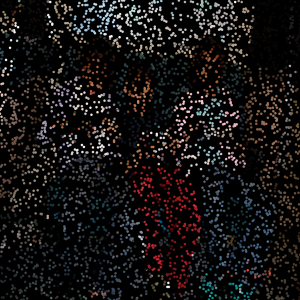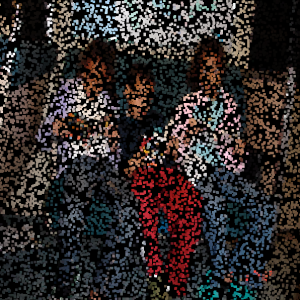sketch
// Sarita Chen
// Section A
// slchen@andrew.cmu.edu
// Project 10
var hills = [];
var clouds = [];
var blocks = [];
var pipes = [];
function setup() {
createCanvas(600, 400);
// create an initial collection of hills
for (var i = 0; i < 5; i++){
var rx = random(width);
hills[i] = makeHill(rx);
}
for (var i = 0; i < 5; i++){
var rx = random(width);
clouds[i] = makeCloud(rx);
}
for (var i = 0; i < 5; i++){
var rx = random(width);
blocks[i] = makeBlock(rx);
}
for (var i = 0; i < 1; i++){
var rx = random(width);
pipes[i] = makePipe(rx);
}
frameRate(20);
}
function draw() {
background(112,166,255);
displayHorizon();
updateAndDisplayHills();
removeHillsThatHaveSlippedOutOfView();
addNewHillsWithSomeRandomProbability();
updateAndDisplayClouds();
removeCloudsThatHaveSlippedOutOfView();
addNewCloudsWithSomeRandomProbability();
updateAndDisplayBlocks();
removeBlocksThatHaveSlippedOutOfView();
addNewBlocksWithSomeRandomProbability();
updateAndDisplayPipes();
removePipesThatHaveSlippedOutOfView();
addNewPipesWithSomeRandomProbability();
backgroundDesign();
}
function updateAndDisplayHills(){
// Update the building's positions, and display them.
for (var i = 0; i < hills.length; i++){
hills[i].move();
hills[i].display();
}
}
function updateAndDisplayClouds(){
for (var i = 0; i <clouds.length; i++){
clouds[i].move();
clouds[i].display();
}
}
function updateAndDisplayBlocks(){
for (var i = 0; i < blocks.length; i++){
blocks[i].move();
blocks[i].display();
}
}
function updateAndDisplayPipes(){
for (var i = 0; i < pipes.length; i++){
pipes[i].move();
pipes[i].display();
}
}
function removeHillsThatHaveSlippedOutOfView(){
var hillsToKeep = [];
for (var i = 0; i < hills.length; i++){
if (hills[i].x + hills[i].breadth > 0) {
hillsToKeep.push(hills[i]);
}
}
hills = hillsToKeep; // remember the surviving buildings
}
function removeCloudsThatHaveSlippedOutOfView(){
var cloudsToKeep = [];
for (var i = 0; i < clouds.length; i++){
if(clouds[i].x + clouds[i].breadth > 0){
cloudsToKeep.push(clouds[i]);
}
}
clouds = cloudsToKeep;
}
function removeBlocksThatHaveSlippedOutOfView(){
var blocksToKeep = [];
for (var i = 0; i < blocks.length; i++){
if(blocks[i].x + blocks[i].breadth > 0){
blocksToKeep.push(blocks[i]);
}
}
blocks = blocksToKeep;
}
function removePipesThatHaveSlippedOutOfView(){
var pipesToKeep = [];
for (var i = 0; i < pipes.length; i++){
if(pipes[i].x + pipes[i].breadth > 0){
pipesToKeep.push(pipes[i]);
}
}
pipes = pipesToKeep;
}
function addNewHillsWithSomeRandomProbability() {
// With a very tiny probability, add a new building to the end.
var newHillLikelihood = 0.007;
if (random(0,1) < newHillLikelihood) {
hills.push(makeHill(width));
}
}
function addNewCloudsWithSomeRandomProbability(){
var newCloudLikelihood = 0.007;
if (random(0,1) < newCloudLikelihood) {
clouds.push(makeCloud(width));
}
}
function addNewBlocksWithSomeRandomProbability(){
var newBlockLikelihood = 0.007;
if (random(0,1) < newBlockLikelihood) {
blocks.push(makeBlock(width));
}
}
function addNewPipesWithSomeRandomProbability(){
var newPipeLikelihood = 0.002;
if (random(0,1) < newPipeLikelihood) {
pipes.push(makePipe(width));
}
}
// method to update position of building every frame
function hillMove() {
this.x += this.speed;
}
function cloudMove(){
this.x += this.speed;
}
function blockMove(){
this.x += this.speed;
}
function pipeMove(){
this.x += this.speed;
}
// draw the building and some windows
function hillDisplay() {
var floorHeight = 30;
var hHeight = this.nFloors * floorHeight;
fill(255);
stroke(0);
push();
translate(this.x, height - 40);
fill(255,213,48);
stroke(255,175,48);
ellipse(0, -hHeight, this.breadth+50, hHeight+100);
pop();
}
function cloudDisplay(){
var floorHeight = 10;
var bHeight = this.nFloors * floorHeight;
noStroke();
push();
translate(this.x,height-40);
fill(170,219,255);
ellipse(10,bHeight,this.breadth+100,bHeight/2);
pop();
push();
translate(this.x,height-40);
fill(170,219,255);
ellipse(30,-bHeight-200,this.breadth+100,bHeight/2);
pop();
}
function blockDisplay(){
var floorHeight = 10;
var bHeight = this.nFloors * floorHeight;
noStroke();
push();
translate(this.x,height-40);
fill(140,78,47);
rect(30,-bHeight-100,30,30);
pop();
}
function pipeDisplay(){
var floorHeight = 10;
var bHeight = this.nFloors * floorHeight;
noStroke();
push();
translate(this.x,height-40);
fill(77,175,28);
rect(30,-bHeight-50,50,70);
rect(20,-bHeight-50,70,10);
pop();
}
function backgroundDesign(){
fill(120,224,60);
noStroke();
rect(0,350,600,50);
fill(255,212,71);
rect(0,370,600,50);
}
function makeHill(birthLocationX) {
var bldg = {x: birthLocationX,
breadth: 50,
speed: -1.0,
nFloors: round(random(1,3)),
move: hillMove,
display: hillDisplay}
return bldg;
}
function makeCloud(birthLocationX){
var cloudV = {x: birthLocationX,
breadth: 20,
speed: -1.0,
nFloors: round(random(1,10)),
move: cloudMove,
display: cloudDisplay}
return cloudV;
}
function makeBlock(birthLocationX){
var blockV = {x: birthLocationX,
breadth: 20,
speed: -1.0,
nFloors: round(random(5,5)),
move: blockMove,
display: blockDisplay}
return blockV;
}
function makePipe(birthLocationX) {
var pipeV = {x: birthLocationX,
breadth: 50,
speed: -1.0,
nFloors: round(random(1,3)),
move: pipeMove,
display: pipeDisplay}
return pipeV;
}
function displayHorizon(){
stroke(0);
line (0,height-50, width, height-50);
}
My project is just a remake of the first world in Super Mario. There are pipes, the basic hills in the background, clouds and item blocks.
(Psyfer)-3.jpg)
![[OLD – FALL 2016] 15-104 • COMPUTING for CREATIVE PRACTICE](https://courses.ideate.cmu.edu/15-104/f2016/wp-content/uploads/2020/08/stop-banner.png)




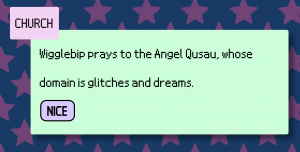
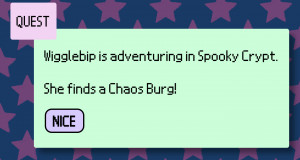
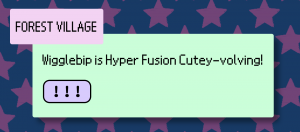
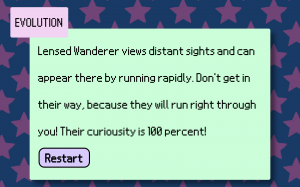
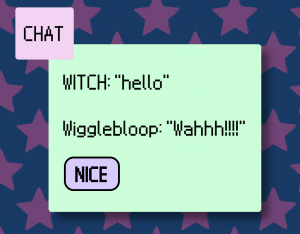


(Psyfer)-3.jpg)

